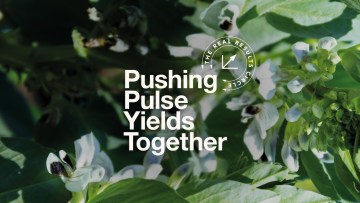April Pulse Check
27.04.2021

In the second of our series, we catch up with pea grower, Chris Eglington and find out why peas are an essential crop within his rotation.
Chris took over the 1,000 acre family farm in Norfolk in 1974. It is farmed in blocks with an eight year rotation of wheat / wheat / winter barley / break crop. The break crop alternates between OSR and peas.
Why are you growing peas?
“You can’t consider the benefits of peas in isolation; on their own peas don’t produce the margins, but as part of the whole rotation, they improve the margins of all the other crops. We always get a good wheat crop following peas, for example, and there are long-term benefits in terms of soil health.”
“On our farm, peas spread the rotation of the rape and help control the associated pests and diseases. As a result, we’ve higher rape yields too.
“We’ve been part of the OSR YEN for three years and recently had the dubious honour of having the highest number of CSFB larvae/plant. While our crop management approach means we’ve very large plants, 55 larvae/plant is still very high. Growing rape just one year in eight should help to reduce populations.”
Tell us about this year’s crop
“This year we’ve four fields of peas. One has so much gravel in it, it has actually got a gravel pit in it. Another field of 27ha contains both lighter land and some of our heaviest land. This does present some challenges, mainly on the machinery front – we can’t use just one type of cultivator to get a good seedbed we use a variety depending upon the soil type.
“This winter was even wetter than last, so our peas are much later going in and were drilled on 1st April. We have managed to get our residual herbicide, Nirvana®, on but since then it’s been too windy to apply fertiliser.
“We’ll be applying potash and polysulphate. While the potash will go on at variable rates, the polysulphate will go on at 100kg/ha.”
How do you establish your peas?
“After we’ve harvested the winter barley and taken off the straw, we plant a cover crop of stubble turnips which is grazed off by sheep. We then prepare the land for the peas in spring.
“Historically we’ve grown yellows but this year we are trying Mankato, a large blue variety, for the first time. I say ‘large blue’, it’s TGW is middle-of-the-range but the seed is certainly a lot smaller than the Kareni white peas we’ve previously grown.
“We variable rate drill and averaged 237kg/ha across the block. We were down at 195kg/ha on the easy land and as high as 290kg/ha on the heavy land. Once drilled, we roll. Not only does it help with harvesting but it improves soil-to-seed contact.”
What are your most challenging weeds, pests and diseases and how to control them?
“We’ve a broad spectrum of weeds on this farm. We do have a small rye grass issue from having dairy cows for so long. Blackgrass isn’t too much of problem and we can rogue it. I prefer to use residual herbicides and we use Nirvana® on the peas as it is the most comprehensive residual there is. It’s done a good job for us for many years.
“While we are trying to move away from using insecticide, we do have to treat for aphids. We normally split the fungicides. How and when will very much depend on the year and the disease pressure.”
How is the crop looking now?
“There’s not too much to report. They are still under ground, though when I dug down I could see they were chitting. They need a good soaking and some warm weather, both in short supply at the moment.”
Our thanks go to Chris for taking the time to share his approach to growing peas. Next month we will be catching up with another grower, in the meantime, if you missed last month’s article with Richard Hinchliffe, north_east click here to find out all about his winter bean crop.

